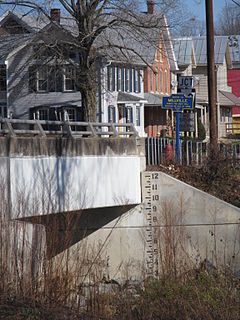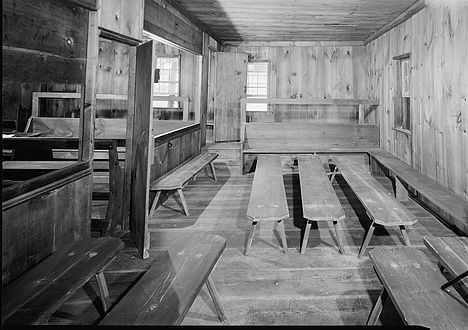
The Amesbury Friends Meetinghouse is a Friends Meeting House at 120 Friend Street in Amesbury, Massachusetts. Built in 1850 under the guidance of John Greenleaf Whittier, it is home to one of the leading Quaker congregations of the region, and historically hosted quarterly meetings for Quakers from across eastern Massachusetts and southeastern New Hampshire. The meetinghouse was listed on the National Register of Historic Places in 2002.

A Friends meeting house is a meeting house of the Religious Society of Friends (Quakers), where meeting for worship is usually held. Typically Friends meeting houses do not have steeples.
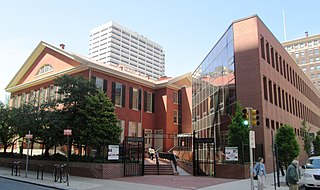
The Race Street Meetinghouse is an historic and still active Quaker meetinghouse at 1515 Cherry Street at the corner of N. 15th Street in the Center City area of Philadelphia, Pennsylvania. The meetinghouse served as the site of the Yearly Meeting of the Hicksite sect of the Religious Society of Friends (Quakers) from 1857 to 1955.

The Buckingham Friends Meeting House is a historic Quaker meeting house at 5684 Lower York Road in Buckingham Township, Bucks County, Pennsylvania. Built in 1768 in a "doubled" style, it is nationally significant as a model for many subsequent Friends Meeting Houses. It was declared a National Historic Landmark in 2003.

The Saylesville Friends Meetinghouse is an historic Quaker meetinghouse on Smithfield Avenue within the village of Saylesville in the town of Lincoln, Rhode Island.
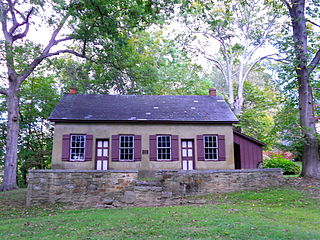
The Colora Meetinghouse is a historic Friends meeting house located at Colora, Cecil County, Maryland, United States.

The Nine Partners Meeting House and Cemetery is located at the junction of NY state highway 343 and Church Street, in the village of Millbrook, New York, United States. The meeting house, the third one on the site, was built by a group of Friends ("Quakers") from the Cape Cod region, Nantucket and Rhode Island in 1780.
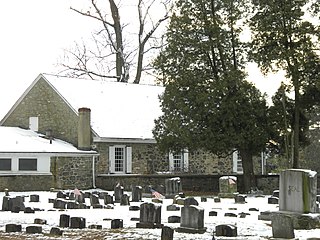
Birmingham Friends Meetinghouse is a historic Quaker meeting house at 1245 Birmingham Road in Birmingham Township, Chester County, Pennsylvania. The current meetinghouse was built in 1763 and added to the National Register in 1971. The building and the adjacent cemetery were near the center of fighting on the afternoon of September 11, 1777 at the Battle of Brandywine. Worship services are held weekly at 10am. The meetinghouse and an adjacent octagonal schoolhouse are listed on the National Register of Historic Places as Birmingham Friends Meetinghouse and School.

Old Kennett Meetinghouse is a historic meeting house of the Religious Society of Friends or "Quakers" in Kennett Township near Chadds Ford, Pennsylvania.

Chichester Friends Meetinghouse is a historic Quaker meeting house at 611 Meetinghouse Road near Boothwyn, in Upper Chichester Township, Delaware County, Pennsylvania. This area, near Chester was one of the earliest areas settled by Quakers in Pennsylvania. The meetinghouse, first built in 1688, then rebuilt after a fire in 1769 reflects this early Quaker heritage. The building was added to the National Register of Historic Places in 1973.
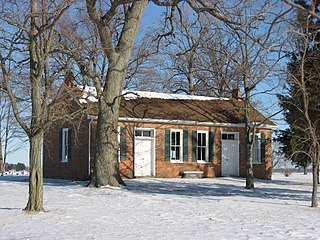
The Green Plain Monthly Meetinghouse is a historic former Quaker house of worship near South Charleston in Clark County, Ohio, United States. Built in 1843, it was used by a part of a monthly meeting that was established in the area in 1822. The original Green Plain Monthly Meeting lasted for only a short while, splitting into Orthodox and Hicksite branches just four years after it was founded: the Orthodox members settled in the community of Selma, while the Hicksites kept the original property. In turn, the Hicksites split in 1843 over the issue of slavery; the liberal party kept the original church, while the conservatives moved to South Charleston-Clifton Road and built the present building.

Appoquinimink Friends Meetinghouse, also known as the Odessa Friends Meetinghouse, is a very small but historic Quaker meetinghouse on Main Street in Odessa, Delaware. It was built in 1785 by David Wilson and added to the National Register of Historic Places in 1972. Members of the meeting, including John Hunn and his cousin John Alston, were active in the Underground Railroad and Harriet Tubman may have hid in the meetinghouse. Measuring about 20 feet (6.1 m) by 22 feet (6.7 m), it may be the smallest brick house of worship in the United States.

Mill Creek Friends Meetinghouse is a historic Quaker meeting house located near Newark, New Castle County, Delaware.

Friends Meetinghouse is a historic Quaker meeting house at 4th and West Streets in Wilmington, Delaware in the Quaker Hill neighborhood. The meeting is still active with a membership of about 400 and is part of the Philadelphia Yearly Meeting. It was built in 1815–1817 and added to the National Register of Historic Places in 1976.

Hopewell Friends Meeting House is an 18th-century Quaker meeting house located the northern Frederick County, Virginia one mile west of the community of Clear Brook at 604 Hopewell Road. Clear Brook, VA 22624. This community was the home of Thomas William "Tom" Fox (1951–2006), a Quaker peace activist, affiliated with Christian Peacemaker Teams (CPT) murdered in 2006 in Iraq.

Millville Friends Meeting House is a meeting house located in Millville, Pennsylvania, and serves as a place of worship for the Religious Society of Friends, also known as Quakers.

Twelfth Street Meeting House was a Quaker meeting house in Philadelphia, Pennsylvania. It was built on the west side of 12th Street, south of Market Street, 1812–13, incorporating architectural elements from Philadelphia's Greater Meeting House (1755).

The Chestnut Hill Friends Meeting is a monthly meeting (congregation) of the Religious Society of Friends (Quakers). First meeting in 1924, they were the first "United" monthly meeting, reconciling Philadelphia Quakers after the Hicksite/Orthodox schism of 1827. The original Meeting House, built in 1931, was located at 100 E. Mermaid Lane in the Chestnut Hill neighborhood of Philadelphia, Pennsylvania. It was replaced in 2012-2013 by the current meeting house, located at 20 E. Mermaid Lane, which incorporates a Skyspace designed by Quaker light artist James Turrell, the second such installation to be incorporated into a working religious space. The new Quaker meeting house is the first to be built in Philadelphia in eighty years.








